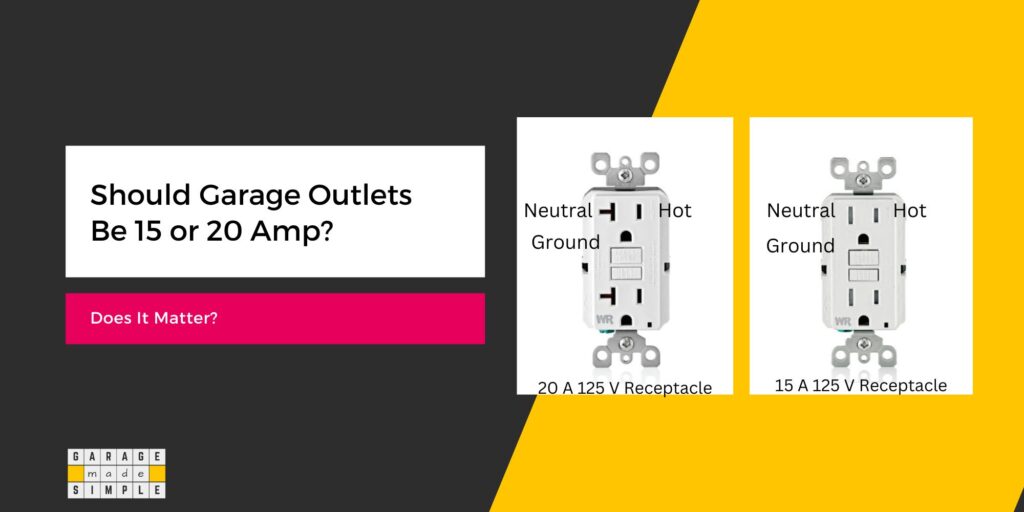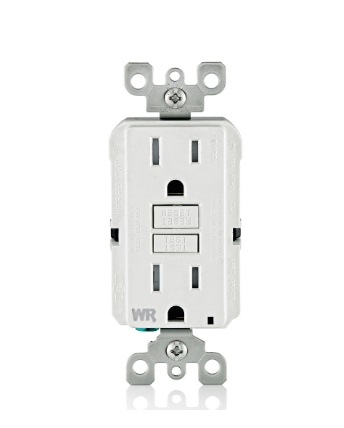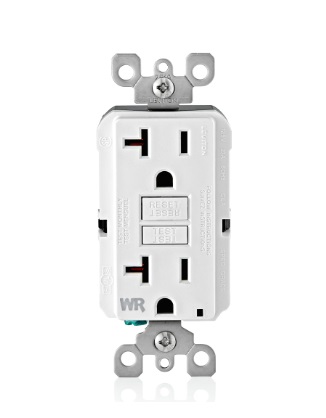Should Garage Outlets Be 15 or 20 Amp? (Does It Matter?)
As an Amazon Associate, I earn from qualifying purchases.
Should Garage Outlets Be 15 or 20 Amp?
Getting ready to wire up your new garage? Or is it just a remodel which requires you to add new outlets? When it comes to installing electrical outlets in a garage, a question often asked is, “Should garage outlets be 15 or 20 Amp”?
2020 NEC code requires that at least one 120-volt, 20-ampere branch circuit shall be installed to supply receptacle outlets in a garage. However, the other garage outlets can be 15 or 20 Amp.
The decision of whether the other garage outlets in your garage will be 15 or 20 Amp depends on the electrical load of the appliances that you intend to use.

What’s the Difference Between a 15 Amp and a 20 Amp Outlet?
Current (Amps), Power (Watts) and Voltage (Volts) are related to each other by a rather simple formula (Ohm’s Law) as under:
Current (Amps) = Power (Watts) / Voltage (Volts)
So if you have a 1200 W heater on a 120 V branch circuit then the current flowing through the circuit will be 10.0 A.
On the other hand if you have a 60 W light bulb on a 120 V branch circuit then the current flowing through the circuit will be 0.5 A.
Should you want to calculate the “Electrical Load” (same as Power) that you can plug into an outlet you just flip the above formula and incorporate a “Safety Factor” of 80%:
Power (Watts) = Current (Amps) X Voltage (Volts) X 80%
Since garage branch circuits in the US are 120V, a 15 A outlet will support an appliance rated at 120 X 15 X 0.80 = 1440 W.
The same calculation for a 20 A outlet will be 120 X 20 X 0.80 = 1920 W.
How to Tell If Outlet Is 15 or 20 Amps?
When you look closely you will find that the GFCI 15 A 125 V outlet / receptacle looks just a little bit different than the GFCI 20 A 125 V outlet / receptacle. The “neutral” prong is like the letter “I” in the case of 15 A but like the letter “T” on its side in the case of 20 A.
You can see it in the images below.
The design difference ensures that a plug meant for a 20 A appliance can not be inserted into a 15 A outlet / receptacle.
The electrical wire thickness is also an indicator. A 15 A outlet will normally use 14-gauge wires, while a 20 A outlet will normally use 12-gauge or 10-gauge wires.
Does a Garage Need 20-Amp Outlets?
As per the NEC code, at least ne 120-volt, 20-ampere branch circuit shall be installed to supply receptacle outlets.
Section 210.11(C)(4) Garage Branch Circuits is specific to outlets in a garage and states that:
In addition to the number of branch circuits required by other parts of this section, at least one 120-volt, 20-ampere branch circuit shall be installed to supply receptacle outlets required by 210.52(G)(1) for attached garages and in detached garages with electric power. This circuit shall have no other outlets.
Exception: This circuit shall be permitted to supply readily accessible outdoor receptacle outlets.
The important point to note here is that the above code uses the word “at least”. As long as this requirement is complied with the other outlets can be 15 A or 20 A.
Does Every Outlet in a Garage Need to Be GFCI?
The “other” outlets in a garage can be either 15 A or 20 A, but each one of them has to be GFCI protected as per the 2020 NEC code.
Section 210.8 of 2020 NEC Ground-Fault Circuit-Interrupter Protection for Personnel states that
Ground-fault circuit-interruption for personnel shall be provided as required in 210.8(A) through (F). The ground-fault circuit-interrupter shall be installed in a readily accessible location.
Garage is listed as one of the locations in Sections 210.8(A)(1) through (11) and as such the detached garage electrical code requires all outlets in a detached garage to be GFCI protected.
Does a Garage Door Opener Need a 20 Amp Circuit?
The power consumed by a Garage Door Opener (GDO) Motor depends mainly on the weight & size of the garage door. The brand and design can also affect the power consumption. Most garage door openers are rated at between 350 W and 600 W.
It is not necessary to have Garage Door Openers (GDO) on a dedicated branch circuit. You may have a GFCI outlet on the same circuit as the Garage Door Opener (GDO) but it is better not to have the garage lights on the same circuit.
Using the formula the current flow for a 600 W Garage Door Opener (GDO) on a 120 V circuit will be 5 amps. A single Garage Door Opener (GDO) can safely be plugged into a 15 A 120 V outlet on a 15 A branch circuit.
Use a dedicated 20 A 120 V branch circuit if you plan to put two or three Garage Door Openers (GDO) on the same circuit.
Can a 15 Amp Outlet Be on a 20 Amp Circuit?
Yes, you can put a 15 amp outlet on a 20 amp circuit.
A 20 amp branch circuit can handle a current flow of 20 A. Even accounting for a safety factor of 80%, a 20 amp circuit can handle a current flow of 16 A. Therefore installing a 15 amp outlet on a 20 amp circuit is perfectly fine.
Obviously you cannot put a 20 amp outlet on a 15 amp circuit. If you do that by mistake you will keep tripping the 15 A circuit breaker all the time.
Bottom Line
The bottom line is that
- The garage must have a minimum of one 20 A 120 V GFCI outlet / receptacle for every parking bay according to the the 2020 NEC code
- The other garage outlets can be either 15 or 20 Amp
- All outlets in the garage must be GFCI compliant as per 2020 NEC code
Thank you very much for reading the post. I do hope you found it informative and useful.








